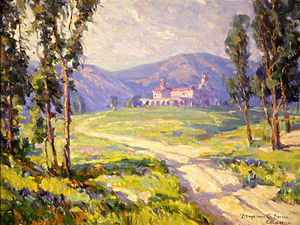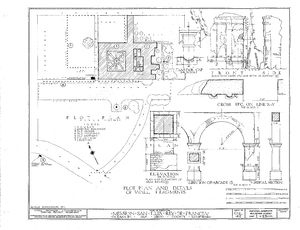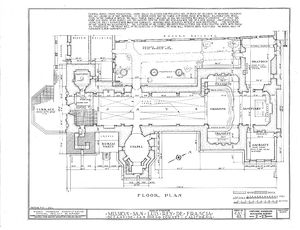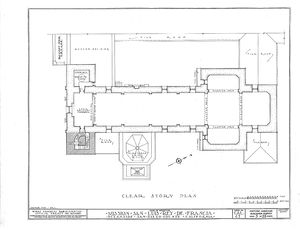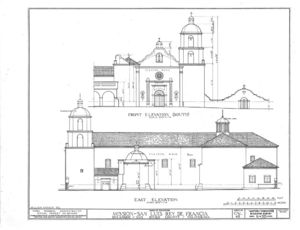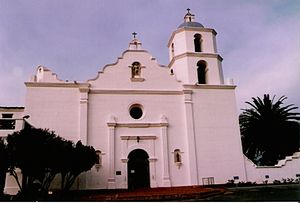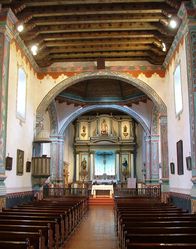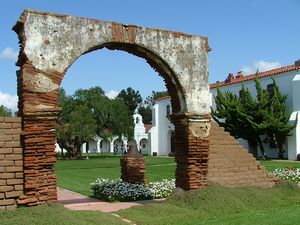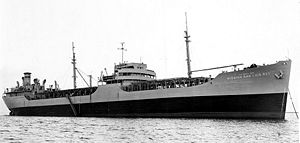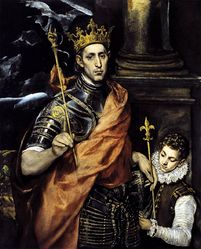Mission San Luis Rey de Francia/Gallery
(PD) Engraving: Schott, Sorony, and Co.
During the Mission Period, natives occupying lands near Mission San Luis Rey de Francia were referred to as Luiseños by the Spaniards.[1](PD) Drawing: Eugene Duflot de Mofras
In 1841, French explorer Eugene Duflot de Mofras produced a sketch of the Mission that depicted a second campanario, thereby supporting the theory that two bell towers were planned, but never completed; the lone tower was also used as a lookout post.[2](PD) Photo: Keystone-Mast Company
Inside the "cavernous" capilla (chapel) at Mission San Luís Rey de Francia, circa 1900. Dedicated in 1815, the cruciform design is shared only with the ruined "Great Stone Church" at Mission San Juan Capistrano, making the two structures unique among the Alta California missions in that regard.[3](PD) Photo: Charles C. Pierce
Mission San Luis Rey de Francia is home to with the first Peruvian Pepper Tree (Schinus molle) planted in California in 1830, visible at right behind the arches in the above photograph (taken circa 1900).[4](PD) Photo: George Wharton James
Illuminated choir missals on display at Mission San Luis Rey de Francia in 1913.[5]© Photo: Robert A. Estremo
Mission San Luis Rey de Francia (seen here in 1986) is architecturally distinctive due to the combination of Spanish, Moorish, and Mexican lines exhibited. Part of California's most pristine mission complex, the baroque façade of the church was meant to be flanked by twin towers.(PD) Photo: Dick Markell / United States Navy
USNS Mission San Luis Rey (T-AO-128) at anchor in the Long Beach / San Pedro, California area.
![(PD) Engraving: Schott, Sorony, and Co. During the Mission Period, natives occupying lands near Mission San Luis Rey de Francia were referred to as Luiseños by the Spaniards.[1]](/wiki/images/thumb/7/78/Kumeyaay.jpg/230px-Kumeyaay.jpg)

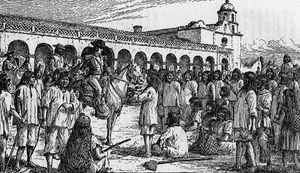
![(PD) Drawing: Eugene Duflot de Mofras In 1841, French explorer Eugene Duflot de Mofras produced a sketch of the Mission that depicted a second campanario, thereby supporting the theory that two bell towers were planned, but never completed; the lone tower was also used as a lookout post.[2]](/wiki/images/thumb/0/0c/1844_Mission_San_Luis_Rey_de_Francia.jpg/300px-1844_Mission_San_Luis_Rey_de_Francia.jpg)

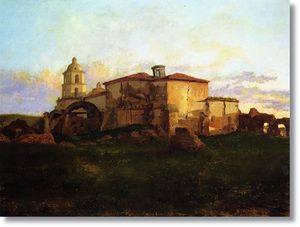
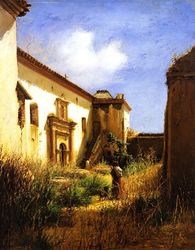
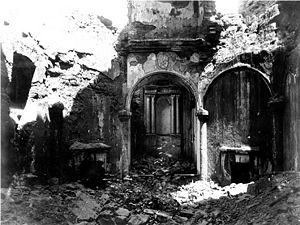
![(PD) Photo: Keystone-Mast Company Inside the "cavernous" capilla (chapel) at Mission San Luís Rey de Francia, circa 1900. Dedicated in 1815, the cruciform design is shared only with the ruined "Great Stone Church" at Mission San Juan Capistrano, making the two structures unique among the Alta California missions in that regard.[3]](/wiki/images/thumb/3/30/San_Luis_Rey_de_Francia_circa_1900_Keystone-Mast_Company.jpg/238px-San_Luis_Rey_de_Francia_circa_1900_Keystone-Mast_Company.jpg)
![(PD) Photo: Charles C. Pierce Mission San Luis Rey de Francia is home to with the first Peruvian Pepper Tree (Schinus molle) planted in California in 1830, visible at right behind the arches in the above photograph (taken circa 1900).[4]](/wiki/images/thumb/f/fa/CHS-2097.jpg/199px-CHS-2097.jpg)
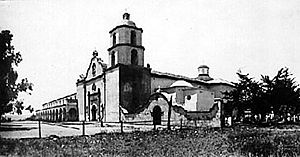
![(PD) Photo: George Wharton James Illuminated choir missals on display at Mission San Luis Rey de Francia in 1913.[5]](/wiki/images/thumb/7/7b/Choir_missals_at_Mission_San_Luis_Rey.jpg/300px-Choir_missals_at_Mission_San_Luis_Rey.jpg)
